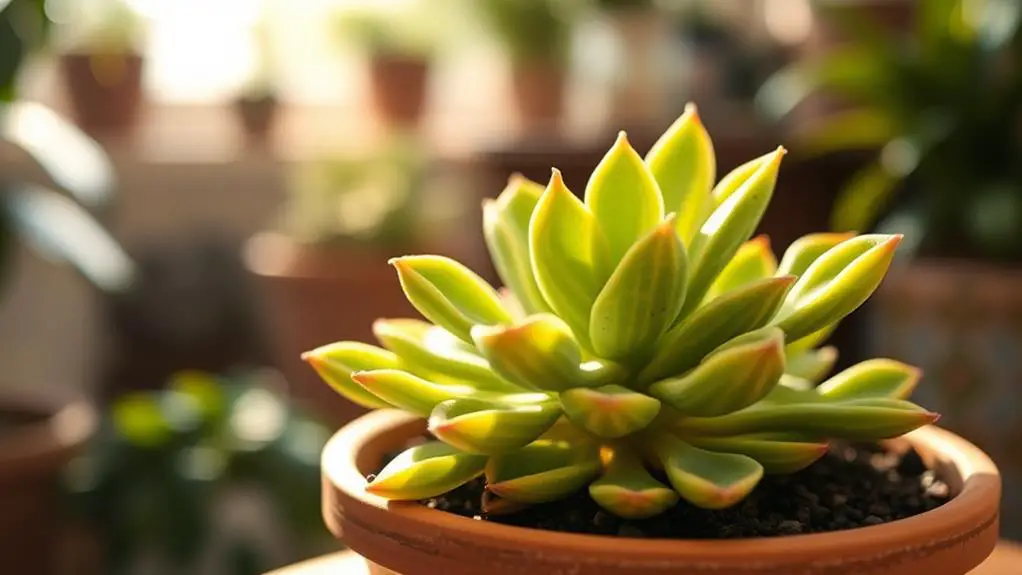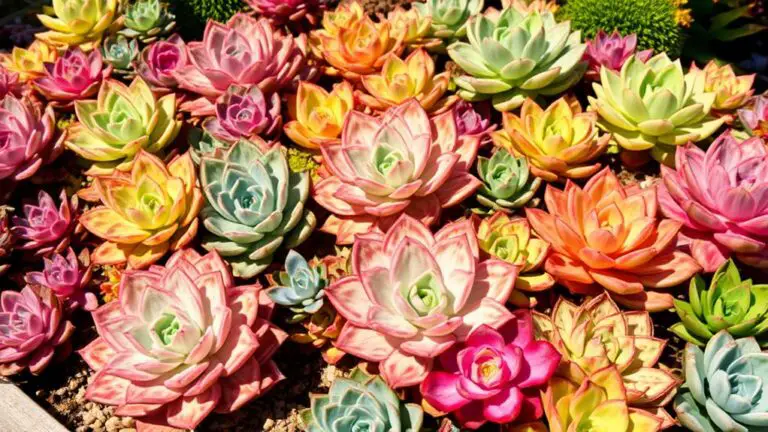Essential Care Tips for Beginners: Tigers Jaw Crassula
If you're new to caring for Tigers Jaw Crassula, you'll find it's a rewarding yet straightforward plant to maintain. Known for its striking tooth-like leaves and bright yellow blooms, this succulent thrives with a few specific conditions. You'll need to provide well-draining soil, ample sunlight, and just the right amount of water to keep it healthy. But what exactly does that entail, and how can you guarantee you're not over or under-doing it? Let's explore the essentials you need to know to keep your Tigers Jaw Crassula in peak condition.
Plant Overview

Tiger's jaw (Faucaria tigrina) is a remarkable succulent native to South Africa, easily recognizable by its unique, tooth-like leaves that look like a tiger's jaw. This plant typically grows up to 6 inches tall and can spread about 12 inches wide, making it perfect for both indoor and outdoor gardens.
You'll love how it adds a touch of greenery and uniqueness to your space. One of the highlights of Tiger's jaw is its bright yellow flowers, which bloom in the fall and winter. These flowers add a burst of vibrant color, making your plant even more intriguing.
The succulent thrives in well-draining soil and requires only occasional watering when the soil is completely dry, which makes it very low maintenance. Your care routine for this plant doesn't have to be complicated. Just verify it has well-draining soil and avoid overwatering.
As an indoor plant, it fits well in homes with pets and children since it's non-toxic. However, it's always a good idea to keep a watchful eye to prevent any accidental ingestion. Overall, Tiger's jaw is an excellent choice for both beginner and experienced gardeners.
Ideal Growing Conditions
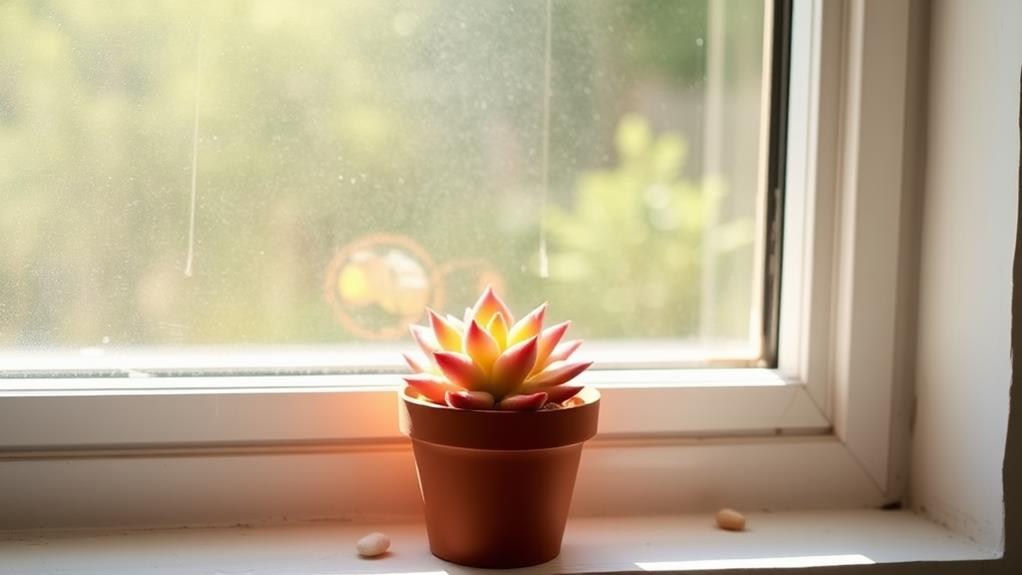
To guarantee your Tiger's jaw thrives, it's important to provide the right growing conditions. Start by ensuring you use well-draining soil, ideally a cactus or succulent mix. This type of soil prevents waterlogging, which can cause root rot.
Your Tiger's jaw loves sunlight and needs about 6 hours of it each day. It can handle full sun to partial shade, which helps with ideal growth and blooming.
Temperature is another key factor. Aim to keep daytime temperatures between 65°F and 80°F (18°C to 27°C). During the fall and winter, it can tolerate cooler conditions.
This succulent is drought-tolerant, so avoid overwatering it. Only water when the soil is completely dry to mimic its natural dry habitat.
Maintaining low humidity levels, below 40%, is also essential. High humidity can lead to fungal issues, which you definitely want to avoid.
Watering Practices
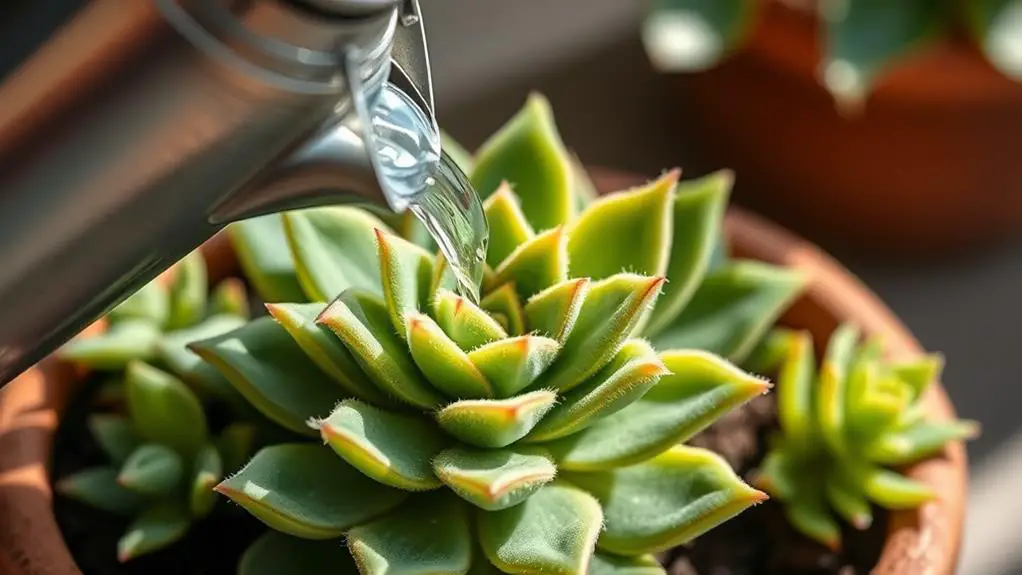
When it comes to watering your Tiger's Jaw Crassula, it's important to let the soil dry out completely between waterings to avoid root rot.
Adjust your watering schedule with the seasons; water more in spring and summer, but cut back to about once a month in fall and winter.
Always keep an eye on your plant's texture—if it feels squishy, it needs water, and if it's firm, you're doing great!
Frequency and Amount
Watering practices for a Tiger's Jaw Crassula are essential to guarantee its health and vigor. You need to pay attention to the frequency of watering. During the growing season, water your plant every 2-3 weeks. Let the soil dry completely between waterings to avoid root rot, a common issue if the soil stays too moist.
Check the soil moisture regularly by touching the soil surface. If it's dry, it's time to water. When you do water, use about 0.5 cups, but remember to adjust this amount based on your environment's humidity and temperature. If the leaves look squishy, it's a sign your plant needs water. On the other hand, firm leaves indicate that the moisture level is just right.
A critical part of your care routine is ensuring proper drainage. Use pots with drainage holes to prevent standing water, which can harm your Tiger's Jaw Crassula. Without good drainage, the roots might sit in water, leading to root rot.
Seasonal Adjustments
As the seasons change, so should your watering practices for Tiger's Jaw Crassula. During the growing season in spring and summer, you'll want to water your plant every 1-2 weeks. This schedule mimics natural rainfall and guarantees the soil moisture is just right.
Be sure to let the soil dry out completely between waterings to avoid overwatering, which can lead to root rot.
In the fall and winter, your Tiger's Jaw Crassula enters a semi-dormant phase. During this time, reduce your watering frequency to once a month. It's vital to allow the soil to dry out thoroughly between waterings.
This adjustment prevents water from sitting in the pot, which could cause root issues.
Always check the soil moisture before watering. A firm texture means the moisture level is good, but if the soil feels squishy, your plant might be thirsty.
Make sure your pot has drainage holes to prevent standing water, which is harmful to the roots.
Adjust care based on how your plant responds. If you notice drooping leaves or mushiness, it's a sign you need to let the soil dry out more.
With these seasonal adjustments, your indoor plant will thrive year-round.
Signs of Overwatering
Identifying signs of overwatering in your Tiger's Jaw Crassula is essential to maintaining its health. Overwatering can lead to yellowing leaves, which signal root stress or damage.
Healthy leaves should feel firm and plump, so if your plant's leaves become mushy or squishy, it's a strong indicator of too much water. Additionally, if the lower leaves start to drop or wilt, it may mean your plant is suffering from root rot due to overly wet soil.
To keep your Tiger's Jaw Crassula thriving, be mindful of these signs of overwatering:
- Yellowing leaves: This can indicate root stress or damage due to excess moisture.
- Mushy or squishy leaves: Healthy leaves should be firm and plump, not soft or watery.
- Drooping or wilting lower leaves: This often points to root rot caused by damp conditions.
Prevent waterlogging by allowing the soil to dry completely between waterings, typically every 12 days.
Consistently damp conditions can lead to black or brown spots on the leaves, suggesting fungal infections that need immediate attention. By following these tips, you'll help guarantee your Tiger's Jaw Crassula remains healthy and vibrant.
Soil and Potting
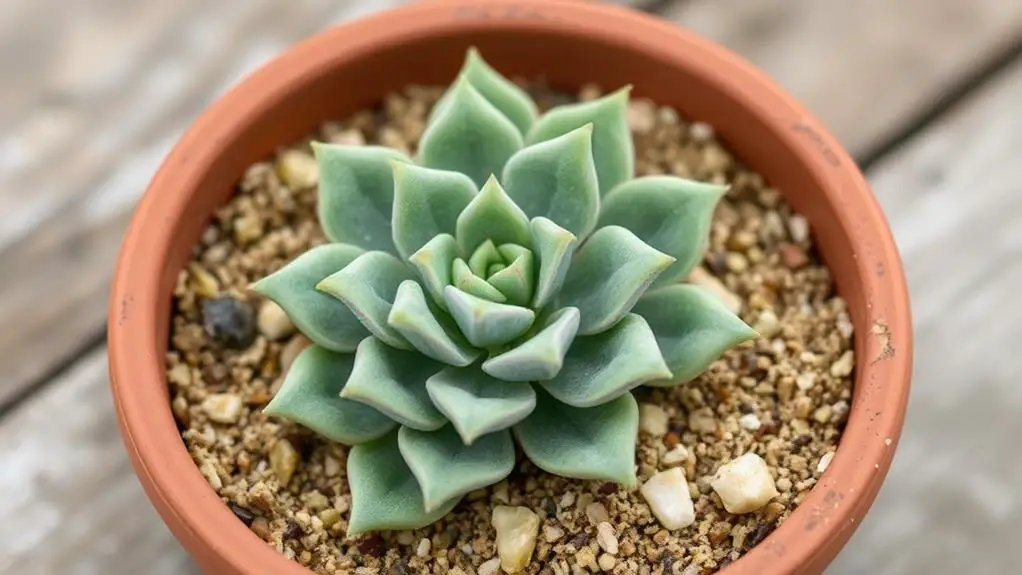
To guarantee your Tiger's Jaw Crassula thrives, it's vital to use the right soil mix and potting techniques. Start with a well-draining soil mix. Ideally, this should consist of two parts sterilized potting soil, one part fine pumice, and one part sand. This combination mimics the plant's native rocky habitat.
Avoid standard potting soil that retains too much moisture; instead, consider using a commercial cactus mix, which is often suitable for this succulent.
When choosing a container, opt for shallow ones with drainage holes. These holes prevent water accumulation and guarantee effective drainage for the plant's roots. Regularly check the soil's moisture levels and let the soil dry completely between waterings to prevent root rot. This is vital for the health of your Tiger's Jaw.
Repot your Tiger's Jaw every 2-3 years or when the plant becomes root-bound. Repotting refreshes the soil and provides adequate space for growth.
Don't worry, repotting isn't as tricky as it sounds! Just be gentle with the roots and guarantee the new pot has good drainage. By following these tips, you'll create the perfect environment for your Tiger's Jaw Crassula to flourish.
Light and Temperature

Tiger's Jaw Crassula thrives when given the right light and temperature conditions. To guarantee your plant stays healthy and produces vibrant indoor plant flowers, it's crucial to pay attention to these factors. Aim to provide 3-6 hours of bright, direct sunlight each day. This light helps promote healthy growth and beautiful blooms. If you're growing it indoors, place it near a sunny window or use grow lights to mimic natural sunlight.
The ideal temperature for Tiger's Jaw Crassula ranges from 65°F to 80°F (18°C to 27°C). During summer, it can handle warmer conditions up to 90°F (32°C). In winter, let the plant experience cooler temperatures around 50°F to 60°F (10°C to 15°C) to help it enter dormancy. Remember, frost can be harmful, so protect your plant from freezing temperatures.
Maintaining average household humidity levels of 30-40% is suitable. Excessive humidity can cause fungal issues, so keep an eye on your plant's environment.
- Provide 3-6 hours of direct sunlight daily
- Keep temperatures between 65°F and 80°F
- Maintain humidity levels around 30-40%
Fertilization Needs
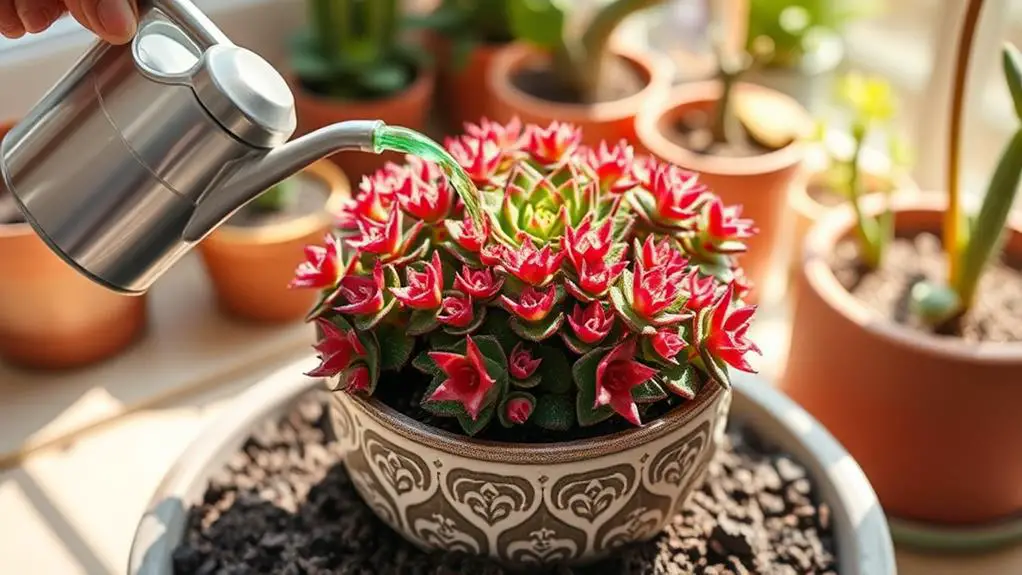
When it comes to fertilizing your Tiger's Jaw Crassula, less is more.
These succulents don't need frequent feeding and actually prefer nutrient-poor conditions.
If you decide to fertilize, use a diluted succulent fertilizer during the growing season to support healthy growth, but skip feeding in the fall and winter to avoid root burn.
Fertilizer Application Frequency
Although Tiger's Jaw Crassula thrives on the nutrients in well-draining soil, it benefits from occasional fertilization during its growing season. To support healthy growth, apply a diluted succulent fertilizer once every 4-6 weeks in spring and summer. During this period, the plant is actively growing and can make the most of the added nutrients.
However, fertilization should cease in fall and winter when the plant enters semi-dormancy. During these cooler months, Tiger's Jaw Crassula doesn't utilize extra nutrients and over-fertilizing can lead to nutrient burn. Using a balanced, diluted fertilizer helps prevent this by ensuring you don't overload the soil with too many nutrients at once.
Remember, repotting your plant every 2-3 years with fresh, nutrient-rich soil is also essential. This practice naturally replenishes the nutrients, reducing the need for frequent fertilization.
Here are a few tips to keep in mind:
- Use a diluted succulent fertilizer: This prevents nutrient burn and keeps your plant healthy.
- Stick to the growing season: Fertilize only during spring and summer.
- Repot regularly: Fresh soil every 2-3 years provides necessary nutrients.
Nutrient-Rich Soil
Guaranteeing your Tiger's Jaw Crassula is planted in nutrient-rich, well-draining soil is essential for its overall health and growth.
You'll want to use a commercial cactus mix, or you can make your own blend with 2 parts sterilized potting soil, 1 part fine pumice, and 1 part sand. This mix prevents root rot and guarantees peak nutrient uptake.
Proper care involves understanding that while Tiger's Jaw doesn't need much fertilization, a diluted liquid fertilizer during the growing season can give it a healthy boost.
Signs that your plant might need extra nutrients include stunted growth and pale leaves. If you see these signs, consider repotting your plant. Repotting every 2-3 years refreshes the soil, providing your Tiger's Jaw with the nutrients it needs to thrive.
Be cautious with fertilizers. Over-fertilizing can cause nutrient burn, which harms your plant. Always dilute the fertilizer to avoid this issue.
Remember, less is more when it comes to fertilizing succulents. By keeping an eye on your plant's soil and nutrient needs, you'll help guarantee your Tiger's Jaw Crassula remains healthy and vibrant.
Happy gardening!
Propagation Techniques

Propagating Tiger's Jaw Crassula can be a rewarding endeavor, especially through its various techniques like offsets and leaf cuttings.
When propagating Tiger's Jaw, start by gently removing offsets from the main plant. Replant these offsets in well-draining soil to guarantee they thrive.
For leaf cuttings, it's best to let the cut end callous for 1-2 days before placing it in soil. This step helps prevent rot and promotes root development.
Keep the soil moderately moist until the cuttings establish roots, usually taking a few weeks. Afterward, shift to normal watering practices.
It's essential to propagate during spring or early summer when the plant is actively growing; this timing guarantees a higher success rate. Providing bright light for your new plants is vital to encourage blooming and healthy growth. As your plants acclimate, monitor them closely for any signs of distress.
Here are some tips to help you with the process:
- Choose well-draining soil: Important for preventing root rot and promoting healthy root development.
- Maintain moderate moisture: Guarantee the soil stays moist but not soggy, especially for new cuttings.
- Provide bright light: Vital for healthy growth and blooming, but avoid direct, harsh sunlight.
Common Pests and Diseases

While propagating Tiger's Jaw Crassula can be rewarding, it's important to be aware of the common pests and diseases that can affect your plants. Regular inspections are vital to catch infestations early. Look for signs like yellowing leaves or webbing. Mealybugs and aphids are common pests; they have a waxy appearance and leave sticky residues on the leaves.
Root rot is another concern, often caused by overwatering. To prevent this, make certain your plant is in well-draining soil and only water when the soil is completely dry. Good drainage is essential for your Tiger's Jaw Crassula.
Fungal infections can occur if the plant is exposed to overly humid conditions. Keep humidity levels low and make certain good air circulation around your plant. This will help prevent diseases from taking hold.
If you spot pests, treat them promptly with insecticidal soap or neem oil. This will help stop them from spreading and causing further damage.
| Issue | Solution |
|---|---|
| Mealybugs/Aphids | Use insecticidal soap or neem oil |
| Root Rot | Make certain good drainage, avoid overwatering |
| Yellowing Leaves | Check for pests, adjust watering |
| Fungal Infections | Maintain low humidity, make certain good air circulation |
Seasonal Care Tips

Caring for your Tiger's Jaw Crassula involves adjusting your routine with the changing seasons to assure the plant thrives year-round.
In the spring and summer, water your plant every 1-2 weeks. Ensure the soil dries completely between waterings to prevent root rot. During these warmer months, provide at least 3-6 hours of bright, indirect sunlight daily. This encourages healthy growth and vibrant blooms.
In the fall and winter, your Tiger's Jaw Crassula enters a semi-dormant state, so reduce watering to about once a month. The plant needs less moisture during this time.
Also, monitor indoor humidity levels, keeping them below 40% to avoid fungal issues. Increase air circulation if needed.
Repot your plant every 2-3 years in the spring. This refreshes the soil and allows room for growth. Use a well-draining cactus or succulent mix to ensure proper drainage.
- Water: Spring/Summer – every 1-2 weeks, Fall/Winter – once a month
- Sunlight: 3-6 hours of bright, indirect light daily in warmer months
- Repotting: Every 2-3 years in spring with well-draining soil
Frequently Asked Questions
How to Care for Tiger Jaws Plant?
Guarantee Tiger Jaws thrive by using well-draining soil, giving 6 hours of direct sunlight, and watering only when soil's dry. Keep temperatures between 65-80°F, and watch for pests, treating infestations promptly.
How Do You Care for Crassula Easy?
Place your Crassula in bright, indirect light for 3-6 hours daily. Water sparingly, letting the soil dry out between waterings. Use well-draining soil and maintain temperatures between 65°F and 80°F. Avoid frost and propagate via offsets.
How Big Do Tiger Jaw Succulent Get?
Tiger's jaw succulents typically grow up to 6 inches tall and spread about 12 inches wide. With ideal care, including enough sunlight and well-draining soil, they might produce offsets and extend their spread even further.
Is Crassula an Indoor or Outdoor Plant?
Crassula, especially Tiger's Jaw, thrives both indoors and outdoors. Indoors, place it near a bright window. Outdoors, give it at least 6 hours of sunlight daily. Just remember to protect it from frost during colder months.
Conclusion
You've got this! Taking care of a Tigers Jaw Crassula is easier than you might think. Just remember to give it plenty of sunlight, water it only when the soil is dry, and use well-draining soil. Keep the temperature and humidity right, and you'll have a thriving plant. With some attention to pests and regular care, your succulent will flourish. Enjoy your gardening journey and watch your Tigers Jaw Crassula grow beautifully!

